Open Access 2017: A Year of Stand-Offs, Showdowns, & Funders’ Own Journals
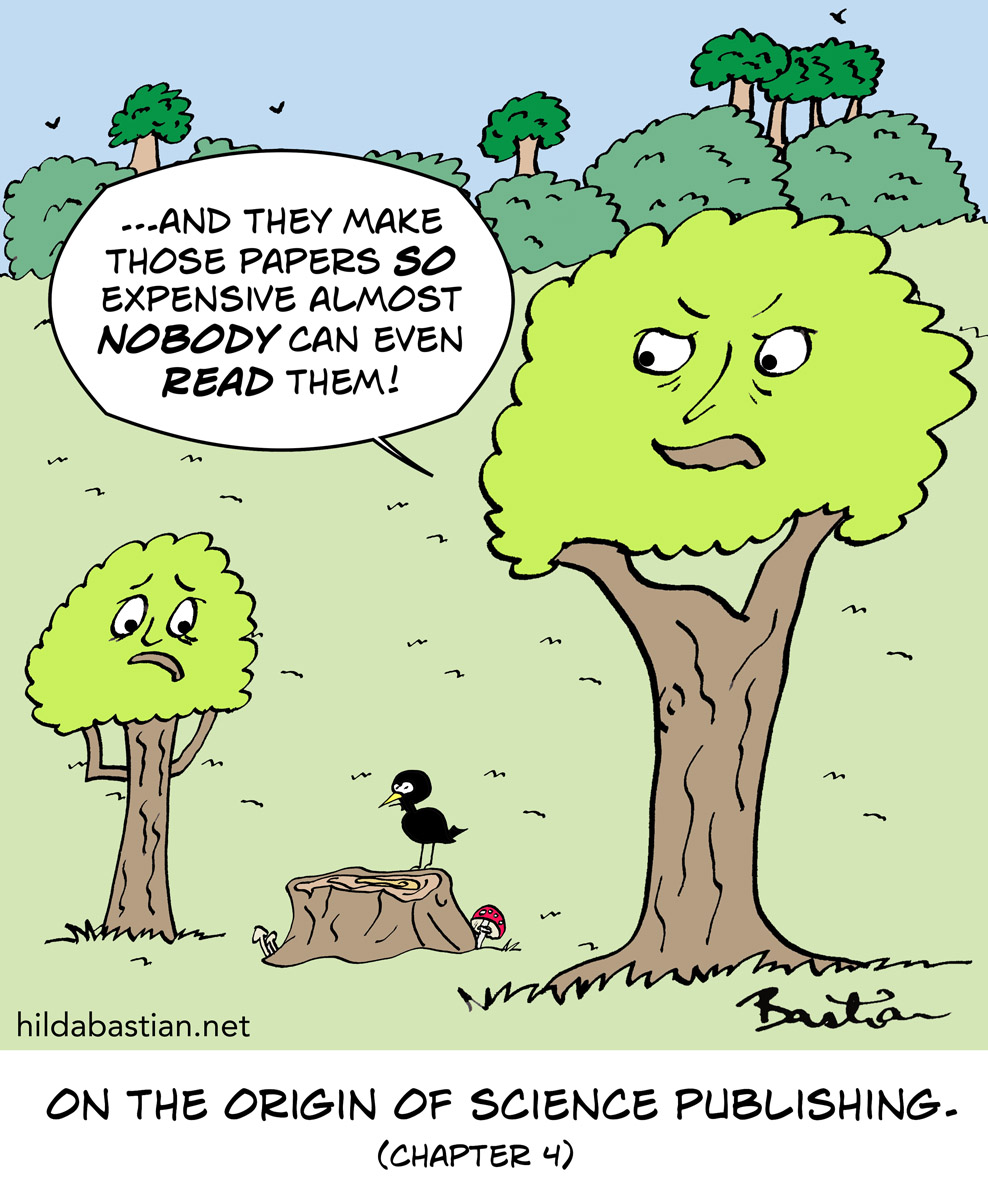
This was the fifth year I tracked events in open access. Sifting through the mass of developments I collected along the way, a couple stood out.
The first is the showdown going on in Germany between the universities and Elsevier. Rolling into 2018 now, the German negotiators aim to hammer out a national access deal that’s sustainable and fair for readers and academic authors – or else pay no subscription at all.
They show no signs of backing down. At year’s end, about 200 academic institutions had cancelled their Elsevier subscriptions.
The second is the emergence of research funder journals/publishing platforms based on the f1000 research model. The Wellcome Trust were the first cab off this rank last year. The goals? More speed, less cost in getting accessible research results out to the world. The model is immediate release with comparatively low author charge, post-publication open peer review, and indexing in PubMed and other bibliographic databases once an article passes enough peer review.
Another to watch? The Gates Foundation stepping away from the embargo that’s come to characterize funders’ open access policies – where articles become free to read, but only a year after publication. If this spreads, it would be a seismic shift.
Last year, along with the increasingly hardball price bargaining, the growth of preprints and Sci-Hub stood out. The implications of both of those kept growing, too. And open access policies continue a slow creep into data and more.
Here’s my take on 2017’s “highlights”, month by month.
January…
The UK’s Medical Research Council (MRC) started the year with:
…actively encouraging researchers to share their pre-peer reviewed manuscripts via established preprint servers. To this end, we are allowing researchers to cite preprints in their grant and fellowship applications. This will come into effect with applications received after 1 April 2017.
(What are preprints? See my background post.)
John Willinsky looked at the history of the subscription for scholarly work, finding an example from Italy in 1612. It was done to enable printing of work that could never turn a profit. Willinsky argued:
It is time to restore the earlier sense of the subscription as underwriting the cost of transforming this particular form of intellectual property into a public good. What is needed is a similarly priced subscription, which permits public access. This would restore the research libraries place as public agents of learned patronage.
Nature reported that articles about research funded by the Bill & Melinda Gates Foundation cannot be published in Nature, Science, and other journals that don’t allow immediate open access. Robert Kiley from the Wellcome Trust said, “We’ll be watching this development closely”.
The University of Calgary axed hundreds more journal subscriptions, bringing their list of cancellations to over 1,600: “the library expects to save $1.5 million in subscription fees this year”. Other Canadian universities going down this road include the University of Ottawa, which cancelled thousands of journals in 2016.
The Swiss universities adopted a policy for open access for all publicly funded research by 2024 [PDF].
James Coyne reported that the University of Groningen went green, requiring all researchers’ publications to be deposited in the university’s repository.
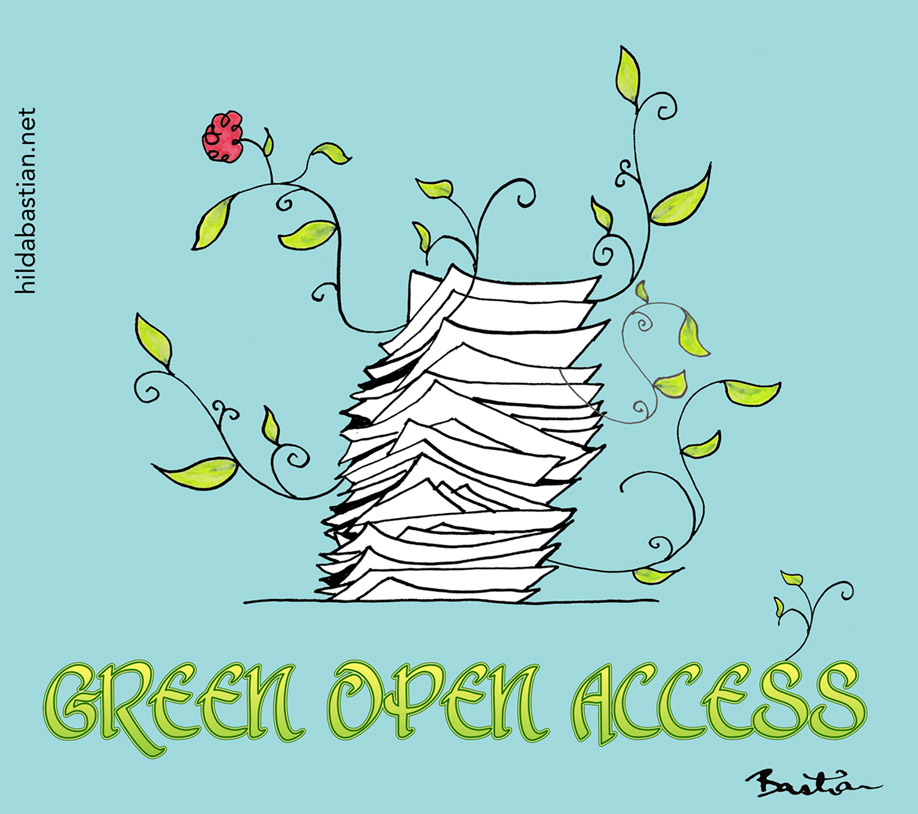
February…
Open access publisher Hindawi terminated their membership of the science publishers’ trade group, STM:
This decision has come as a result of STM’s overwhelming focus on protecting business models of the past, rather than facilitating new models that Hindawi believes are both inevitable and necessary in order for scholarly publishers to continue contributing towards the dissemination of scholarly research in the years to come.
Elsevier announced that even though they were still in a stand-off with Germany about renewing subscriptions, they would resume supplying to the German institutions whose subscriptions had run out by the end of 2016. Meanwhile, Germany had found it relatively easy to cope without the subscriptions:
The loss of access to Elsevier content didn’t overly disturb academic routines, researchers say, because they found other ways to get papers they needed, or because Elsevier journals happened not to be of prime importance in their fields. To help scientists cope with the situation, librarians organized speedy inter-library loans.
And AAAS reached a deal with the Gates Foundation after all, so immediate open access at Science was now possible.
Louisiana State University took Elsevier to court over a contract dispute.
The European Space Agency (ESA) announced an open access policy for images and data.

March…
The Open Library of Humanities flips subscription journals over to their platform, where open access is funded by a consortium of libraries carrying the journals costs. Martin Paul Eve discussed the economics:
The essential logic that we try to follow is that, in any round, the total additional funds that we request from our libraries should be less than what they would currently be paying for the subscription journals that we are flipping.
An EU spokesperson confirmed they would be the next major research funder to launch their own open access journal/publishing platform, going down the path broken by the Wellcome Trust. (More on that [PDF].) And the Gates Foundation announced they were joining this party, too.
£7.3 million: that’s how much was spent on author processing charges (APCs) for research funded by the UK charities in the Charity Open Access Fund (COAF). They’ve reached 91% compliance, but the cost keeps increasing – the hybrid (subscription) journals cost more than the “gold” fully open access journals.
Librarian, Aaron Tay, compared a bunch of the legal services for finding free-to-read versions of articles: Google Scholar’s button came out tops. (Interested in Google Scholar? Adam Rogers wrote about its origins and implications in Wired.)
PubMed added a linked icon option for participating institutional repositories that have green open versions beyond those in PubMed Central.
The National Institutes of Health (NIH) announced that as of May 2017, preprints would count in grant applications, and as products of grants.
In the Netherlands, the universities negotiating for better publishing deals used a freedom of information application to try to crack the secrecy about what’s paid to publishers [PDF].
Meanwhile, negotiations broke down between Germany and Elsevier for a reasonably priced national subscription, allowing for open access publication by German researchers. From the side of the negotiators for the universities (my translation):
After five meetings I’m asking myself if Elsevier is serious about a contract with German science on gold open access.
Elsevier said the German negotiators were being “unreasonable”, and urged a return to the negotiating table.
April…
Germany’s technical institutes ended their subscription negotiations with Elsevier and joined the universities’ Projekt Deal.
The Initiative for Open Citations (I4OC) was announced: the coalition of publishers and others released about 40% of all citations – open and paywalled articles – in CrossRef, and it reached 47% at the end of September.
The Association of Research Libraries (ARL) released information and developments in the Louisiana State University (LSU)-Elsevier lawsuit.
May…
Another update on the LSU-Elsevier lawsuit – but still no resolution reported.
The Academy of Finland announced that open access will be required for articles from the research it funds.
Meanwhile the universities in the Netherlands (VSNU) launched a campaign for open access, along with a journal browser.
June…
Elsevier won a round in a US court: $15 million damages ordered against the paywall-busting website, Sci-Hub – although Sci-Hub isn’t in the US, so this arm doesn’t reach. The American Chemical Society (ACS) filed suit, too. Through it all, Sci-Hub kept going. Sci-Hub’s founder, Alexandra Elbakyan, was interviewed in June as well.
Meanwhile Germany’s Projekt Deal had a win: a publisher organization had complained to the Bundeskartellamt, Germany’s national competition agency, that this was an unfair restriction on trade. The Bundeskartellamt decided against taking action.
The universities of Berlin cancelled their Elsevier subscriptions and issued a we-stand-with-Projekt-Deal statement.

July…
The universities of Baden-Württemberg (the German state including Stuttgart and Heidelberg) cancelled their Elsevier subscriptions and issued a we-stand-with-Projekt-Deal statement. And so did the Robert Koch Institute.
(There’s a story in English of what was happening with the German universities and Projekt Deal here.)
£15.9 million: That was how much the Research Councils of the UK (RCUK) paid in author charges the previous year – again, hybrid journals cost more.
Daniel Himmelstein and colleagues published an analysis of Sci-Hub’s coverage of the literature – and said in an interview:
…this is the beginning of the end for subscription scholarly publishing. I think it is at this point inevitable that the subscription model is going to fail and more open models will be necessitated. One motivation for doing the study is that I want to bring that eventuality into reality more quickly.
The Wellcome Trust issued a new policy on data management and sharing – including software and research materials.

August…
Juan Pablo Alperin looked at recent analyses, and concluded that close to half of 2015’s research papers were now free to read, either in journals or at repositories. (Going back to 2015 goes past the 12-month embargo that many articles wait through.)
Matthew Cobb wrote about the prehistory of preprints in biology: the NIH’s Information Exchange Groups in the 1960s.
Science covered Projekt Deal, with the title: “A bold open-access push in Germany could change the future of academic publishing”.
The Finnish libraries were having difficulty reaching a satisfactory agreement with Elsevier.
The 16 Helmholtz centers cancelled their Elsevier subscriptions and issued a we-stand-with-Projekt-Deal statement.

September…
Elizabeth Shearer, from Confederation of Open Access Repositories (COAR), and Heather Joseph, from SPARC, wrote about their concerns of the implications of Elsevier’s recent takeover of bepress, a software platform used by many institutional repositories:
…consolidated control has led to unaffordable costs, limited utility of research articles, the proliferation of western publishing biases, and a system in which publisher lock-in through big deal licenses is the norm. This situation is damaging for the research enterprise, individual researchers, and for society. Further consolidation of the market across functions and platforms—including key elements like research information systems and open access repositories—will exacerbate this already unhealthy situation.
October…
Ireland’s Health Research Board (HRB) announced their plans to develop their own journal/publishing platform, on the Wellcome Trust model. Then there were 4!
Elsevier and ACS sued Researchgate for copyright infringement.
Stephen Hawking put his PhD thesis online to promote access to research – and the interest crashed the university’s website. Virginia Barbour led with this in an overview of open access’ past and future:
…open access will continue to advance piecemeal, unless we have a long-term clarification of what we’re aiming for and how to get there.
Why Open Research? – a project from Erin McKiernan and John McKiernan – released this image for Open Access Week:
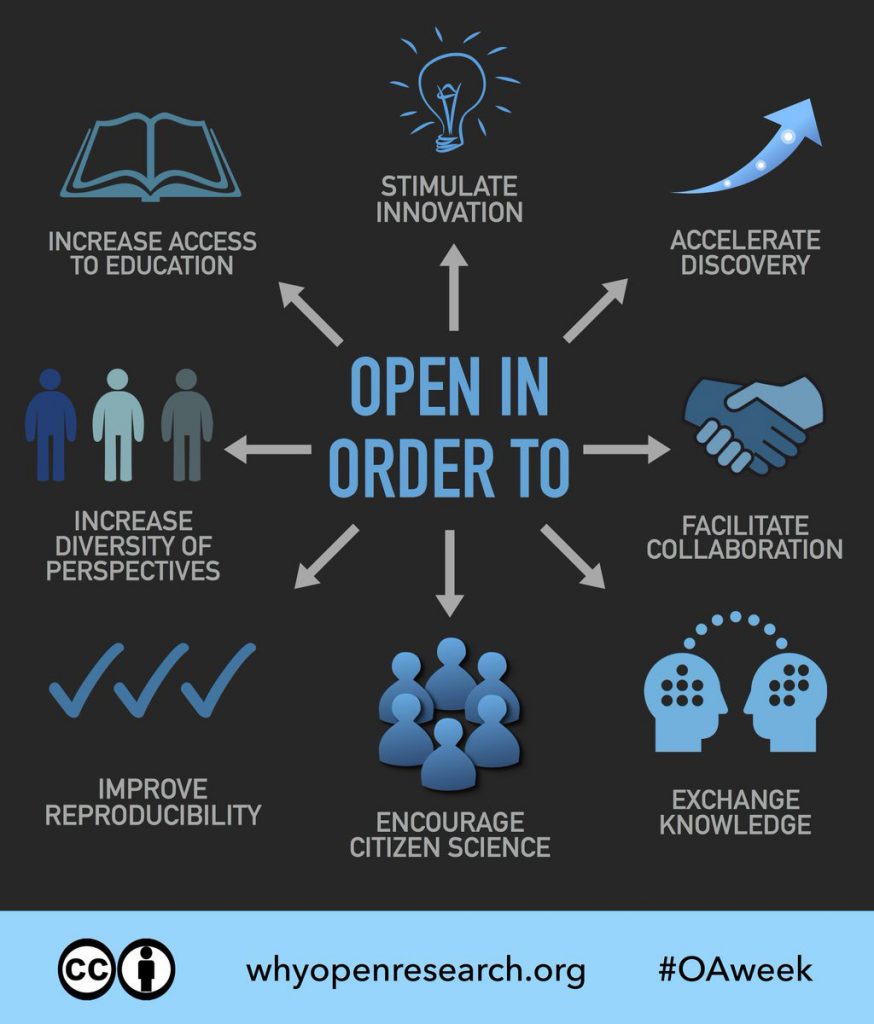
November…
Can a university compel its academics to publish open access? A group of academics from the University of Konstanz set out to challenge this in the German Federal Constitutional Court. The University of Konstanz describe the background.
Aaron Swartz would have turned 31 this month. An annual hackathon is held in his honor.
The first papers were published on Gates Open Research, and at the end of its first year, there were 142 articles in Wellcome Open Research. And then there were 5! Nelson Torto from the African Academy of Sciences (AAS) announced they are following this model too.
The NIH issued a statement aimed at stemming the tide of publications from NIH-funded research in “predatory” journals.
December…
A team from the Ottawa Centre for Journalology capped off a year of research on “predatory” journals with proposals for how stakeholders can address problems inadequate journals cause.
Patti Brennan reported that PubMed Central, the National Library of Medicine’s full text repository, clicked over the 1 billion downloads mark. (And so did arXiv sometime recently.)
The Swiss National Science Foundation (SNSF) set a goal of 2020 for all their funded research to be free to read.
The libraries in Finland reached a national subscription deal with Elsevier. More than 2,600 members had signed onto the “no deal no review” campaign, boycotting peer review for Elsevier journals to demand fair pricing.
Diego Gomez was cleared of all charges at last. The Colombian graduate student had faced criminal charges for sharing a thesis (not his) online. Astonishing, isn’t it?, that it could ever have come to that.
And so ended what Diana Kwon summed up as “A turbulent year in the publishing world”.
~~~~

Previous annual open access roundups:
The cartoons are my own (CC BY-NC-ND license). (More cartoons at Statistically Funny and on Tumblr.)
The photo of Mars is from the European Space Agency (ESA), via Wikimedia Commons.
I don’t know the origin of the Isaac Newton open access meme.
* The thoughts Hilda Bastian expresses here at Absolutely Maybe are personal, and do not necessarily reflect the views of the National Institutes of Health or the U.S. Department of Health and Human Services.

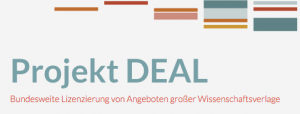
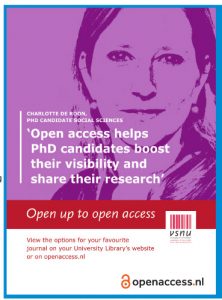
Hilda Bastian, I enjoyed reading your article and you provided an excellent review about Open Access developments in 2017. I’m still waiting for (Machine 2 Machine Learning/IoT) to see IBM Watson (Semantic Web) to team up with Google Deep Mind Alpha Go Zero (A.I. self-taught 3D Algorithm modeling) to read, process and model petabytes of available Open Access Journal Articles, Open Data Research and Open Access Research Protocols/Workflows, i.e. https://www.protocols.io , etc. Maybe this year, maybe next year? As they say, “Your imagination can take you anywhere.” Enjoy 🙂
Great article in a series of great articles, thank you for posting!